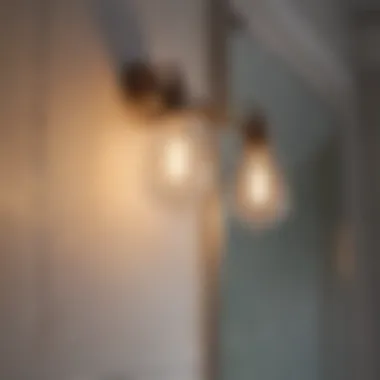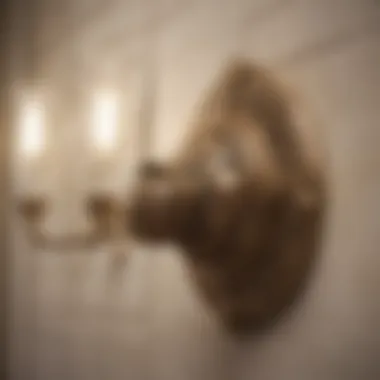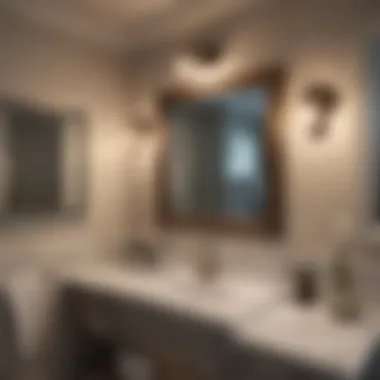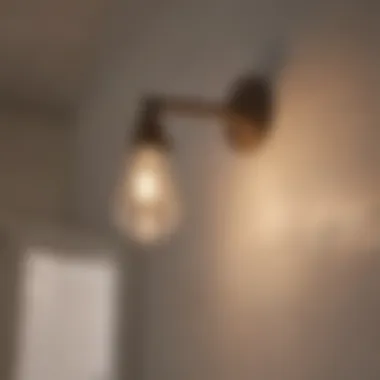A Comprehensive Guide to Traditional Bathroom Light Fixtures


Intro
When it comes to designing a bathroom, lighting plays an essential role in creating the right atmosphere. Traditional bathroom light fixtures embody a classic charm that can enhance both aesthetics and functionality. This guide will explore the various styles, materials, and practical considerations associated with these fixtures. By understanding how traditional lighting options work, homeowners can craft a cohesive and inviting space.
Traditional light fixtures offer more than just illumination. They can serve as decorative elements within the bathroom, often reflecting the overall design theme of the home. Furthermore, the careful selection of light fixtures can impact the perception of space, color, and ambiance. In this article, readers will gain insights not only into choosing the right style but also into effective installation and maintenance tips.
Understanding Traditional Bathroom Light Fixtures
Traditional bathroom light fixtures play a vital role in the overall aesthetic and functionality of a bathroom. They are not just sources of illumination; they contribute to the space's character and charm. By understanding these fixtures, homeowners can make informed decisions that impact both the functionality of their bathrooms and their design goals.
Definition and Characteristics
Traditional bathroom light fixtures refer to a variety of lights designed with classic styling in mind. These fixtures often incorporate design elements such as ornate metalwork, frosted glass shades, and vintage-inspired designs that echo earlier architectural periods.
Some key characteristics include:
- Material Quality: Typically made from durable materials such as brass or wrought iron, enhancing both longevity and style.
- Design Aesthetics: Features simple lines and intricate details, often drawing from historical styles like Victorian or Colonial.
- Light Quality: Provides soft, warm light that creates a welcoming atmosphere, essential for a personal space like a bathroom.
Historical Context
The evolution of traditional bathroom light fixtures is closely linked to advancements in lighting technology and changing design preferences. Originally, bathrooms were often overlooked in terms of design. Early lighting solutions primarily focused on functionality rather than aesthetics.
In the late 19th and early 20th centuries, with the rise of the Arts and Crafts Movement and Art Deco styles, bathrooms began to gain more attention. Fixtures started to reflect the intricate designs and craftsmanship of the time. Today, these historical influences remain evident in many traditional fixtures, bringing a sense of history into modern homes.
Key Elements of Design
When considering traditional bathroom light fixtures, several design elements stand out:
- Shape and Size: Fixtures come in various shapes, including cylindrical, rectangular, or even whimsical styles, and sizes to fit different spaces.
- Finish: The finish can greatly affect the look – polished nickel, antique bronze, or brushed gold are popular choices that can change the feel of the bathroom.
- Bulb Type: The choice of bulb also matters, as incandescent and LED options provide different levels of brightness and warmth.
- Mounting Styles: Choices range from wall-mounted sconces to hanging fixtures, affecting the ambient lighting.
Overall, understanding these aspects can help in selecting fixtures that complement the existing decor while serving practical purposes in the bathroom.
Types of Traditional Bathroom Light Fixtures
Traditional bathroom light fixtures play a significant role in defining the character of a bathroom. They not only provide functional illumination but also enhance the overall design aesthetic. Various styles of light fixtures cater to different needs and design preferences, allowing homeowners to create a space that feels both inviting and practical. In this section, we will explore four main types of traditional bathroom light fixtures: wall sconces, vanity lights, flush mounts, and chandeliers. Each type has unique benefits and considerations that contribute to its effectiveness in a bathroom setting.
Wall Sconces
Wall sconces are versatile fixtures that can add depth and warmth to a bathroom. Typically mounted on the walls, these lights can serve both functional and decorative purposes. They can illuminate specific areas like mirrors or artwork, making them ideal for enhancing visibility. Moreover, their positioning can reduce shadows cast by overhead lighting, improving overall illumination.
There are several styles of wall sconces available. These can range from classic candle-inspired designs to more modern flush-mounted variants. Homeowners should consider the height and spacing of wall sconces to avoid over-lighting or under-lighting key areas. Generally, wall sconces should be placed at eye level, providing light that complements rather than overwhelms.
Vanity Lights
Vanity lights are essential in areas where grooming and personal care are done. These fixtures are often installed above or alongside mirrors, making them crucial for tasks like shaving or makeup application. A well-lit vanity area can improve the functionality of a bathroom, creating a more user-friendly space.
The design of vanity lights can vary greatly, with options including multi-bulb fixtures and single sconces. The choice of finish—whether polished nickel, bronze, or brushed gold—can significantly affect the style of the bathroom. Vanity lights should provide even illumination, avoiding harsh shadows that could make grooming more difficult.
Flush Mounts
Flush mounts, as the name implies, are fixtures that are mounted directly to the ceiling. These lights provide a clean and streamlined look, making them suitable for bathrooms with low ceilings. Their design can vary from traditional to contemporary, ensuring they suit a wide range of aesthetics.
One of the key benefits of flush mounts is their space-efficiency. They offer a broad spread of light without protruding too far into the space. This is particularly valuable in smaller bathrooms where large fixtures may feel overwhelming. Proper selection based on brightness and style is important to achieve desired ambiance.
Chandeliers
Chandeliers are a statement fixture that can add a layer of elegance to a bathroom. Traditionally associated with larger spaces, they can also be effectively utilized in bathrooms, provided there is sufficient ceiling height. A chandelier can elevate the overall design while providing adequate illumination.
When choosing a chandelier for a bathroom, homeowners should consider the size and scale of the space. A large chandelier can become a focal point, but it may require careful planning regarding placement. Moreover, considering moisture-resistant materials is crucial for durability in a bathroom environment.


"Choosing the right type of light fixture is not solely about aesthetics; it also impacts functionality and the overall experience within the space."
Materials Used in Traditional Light Fixtures
The choice of materials used in traditional bathroom light fixtures holds considerable importance. It impacts not only the aesthetic appeal but also functionality and durability. Understanding materials allows homeowners and designers to make informed decisions when selecting fixtures that both complement and enhance the overall design of a bathroom.
Metal Finishes
Metal finishes are a cornerstone of traditional light fixtures. Options such as brass, bronze, and nickel provide distinctive textures and hues that suit various bathroom styles.
- Brass often brings warmth and can develop a beautiful patina over time. It works well in spaces designed to evoke a historical ambiance.
- Bronze offers strength and a rustic feel, popular in vintage or farmhouse styles.
- Nickel represents a sleek, polished alternative that lends itself to a more contemporary take on tradition.
The choice of metal finish influences the fixture’s ability to resist tarnishing and corrosion, which is critical in a high-moisture environment like a bathroom. For optimal longevity, selecting materials that are treated to withstand humidity is essential.
Glass Options
Glass is another vital component in constructing traditional light fixtures. The type of glass used can significantly affect the dispersal of light and the ambiance of the space.
- Frosted glass diffuses light more evenly, creating a soft glow ideal for settings where relaxation is key.
- Clear glass can highlight decorative bulbs, making it perfect for areas focused on design appeal.
- Colored glass offers a unique touch, influencing the mood with its tint.
When opting for glass, consider aspects such as maintenance and stylization. Glass requires regular cleaning as it can easily show fingerprints and water spots. Proper care ensures that the fixtures maintain their charm and efficiency.
Wood Elements
Wood elements in light fixtures provide a natural and warm aesthetic, a significant characteristic of traditional designs. Fixtures often incorporate woods like oak, maple, or walnut that can enhance the rustic or classic vibe of the bathroom.
Incorporating wood adds texture and can balance out harder materials like metal and glass. It’s important to ensure that the wood used is treated to endure moisture and prevent warping or degradation. Additionally, wood offers flexibility; it can easily be stained or painted to match existing decor.
Overall, the materials chosen for traditional bathroom light fixtures significantly influence both style and functionality. An informed selection will elevate the bathroom’s decor while ensuring longevity and practicality. Engaging with these materials allows for the expression of personal taste in a crucial space within the home.
"The right materials not only enhance beauty but also the durability of traditional fixtures in bathrooms."
By understanding the divergence in metal finishes, glass options, and wooden elements, homeowners can create spaces that are both beautiful and functional.
The Role of Lighting in Bathroom Design
Lighting in a bathroom serves an essential function beyond mere visibility. It extends to enhancing the overall design and setting the ambiance of the space. The right fixtures create a harmonious environment that blends both functionality and beauty. Understanding how lighting plays a role in bathroom design can greatly influence the aesthetic and practical aspects of your home.
Enhancing Aesthetic Appeal
Traditional bathroom light fixtures contribute significantly to aesthetic appeal. They add charm and character, aligning with the overall design theme of the space. Each fixture's style can range from ornate chandeliers to sleek sconces, each offering different visual impacts. For instance, a vintage-style fixture can transport the room back to a different era, creating a cohesive look that resonates with traditional decor.
When carefully selected and placed, these fixtures can become statement pieces. They draw the eye and invite admiration. Proper illumination from these fixtures also reflects off surfaces, enhancing textures and colors, thereby elevating the entire atmosphere of the bathroom. This is particularly impactful with finishes like polished brass or matte black, which can transform the room's character.
Functional Benefits
Functionality is another key role of bathroom lighting. Well-designed lighting should provide adequate illumination for daily tasks. Activities such as shaving, applying makeup, or even reading promotional products require enough light to avoid shadows and dim spots. Therefore, wall sconces on either side of a mirror are often recommended for their ability to minimize shadowing.
Additionally, the choice of light temperature is crucial. Warmer tones can make a space feel inviting, while cooler tones can promote alertness. Also, incorporating adjustable lighting or dimmers can enhance functional flexibility, allowing users to alter the brightness based on the specific activity—bright for day-to-day grooming and softer for a more relaxing bath.
Mood Setting
Lighting significantly influences the mood in a bathroom. The characteristics of the lighting—its color, brightness, and placement—can alter how the space feels. Warm light creates a soft, inviting environment ideal for relaxation, while bright, cooler light can energize and awaken.
A layered lighting approach is particularly effective in achieving desired moods. This might involve combining ambient lighting from overhead fixtures with accent lighting from wall sconces. Such a combination allows for both general illumination and options for mood adjustment through strategic placement of light.
Consider the overall vibe you want to create. Thoughtful lighting can enhance relaxation, transforming a bathroom into a serene retreat after a long day.
In summary, the role of lighting in bathroom design transcends mere illumination. It touches on aesthetic appeal, provides necessary function, and sets the mood, enriching the user experience significantly. By recognizing these elements, homeowners can make informed decisions when selecting traditional bathroom light fixtures.
Choosing the Right Light Fixture


Selecting the right light fixture for a bathroom is not merely a matter of aesthetics; it plays a crucial role in enhancing the space's overall functionality and mood. Traditional bathroom light fixtures offer a unique blend of elegance and practicality. These fixtures can highlight architectural features, create an inviting ambiance, and ensure safety during daily routines. Therefore, understanding the key considerations when choosing these fixtures is vital for homeowners and interior design enthusiasts alike.
Considerations for Size and Scale
When planning the layout of your bathroom lighting, size and scale are foundational factors. A light fixture that is too large can overwhelm a small bathroom, while a small fixture may get lost in a larger space. To achieve balance, measure the area where the fixture will be installed. Generally, for wall sconces, the height should be about 66 to 72 inches from the floor.
Consider the following guidelines:
- For a single vanity, a fixture around 24 to 30 inches wide is advisable.
- For a double vanity, opt for a fixture that is at least 48 inches wide or two separate fixtures that are appropriately spaced.
Crafting a harmonious bathroom design requires attention to these dimensions, ensuring that lighting complements other elements in the room without dominating them.
Fixture Style Compatibility
Traditional light fixtures come in various styles, from Victorian to Craftsman. Ensuring that the style of your chosen fixture aligns with the bathroom's overall design theme is vital. A mismatch can lead to a disjointed appearance, detracting from the beauty of your space. Consider the following types of fixtures and their compatibilities:
- Wall sconces work exceptionally well with vintage or rustic decors.
- Vanity lights are excellent for classic and modern combinations, depending on their finish and design.
- Chandeliers can add a touch of sophistication to a more grand or spacious bathroom setting.
Evaluate the existing decor and architectural details when selecting fixtures to maintain a cohesive look throughout the bathroom.
Color Temperature and Brightness
The color temperature and brightness of light fixtures impact the mood and functionality of a bathroom. Traditional light fixtures typically offer different color temperatures, measured in Kelvin. Generally, a cooler temperature of 3000K to 4000K is suitable for task-oriented areas like vanities, while warmer options (2700K to 3000K) create a soothing atmosphere.
It's essential to also consider:
- Lumens: The total amount of light output. For a bathroom, 200-400 lumens per fixture is a typical range.
- Dimmable options: Allow for adaptability depending on the time of day or specific needs. For instance, bright lighting is ideal during morning routines, while softer light is preferred in the evenings.
"Selecting the correct color temperature not only enhances visibility but also contributes to a calming bathroom environment."
In summary, choosing the right light fixture for a traditional bathroom involves an understanding of size and scale, compatibility with the bathroom's overall style, and considerations of color temperature and brightness. Each of these elements works together to create a space that is both functional and aesthetically pleasing.
Installation Best Practices
Understanding the importance of installation best practices for traditional bathroom light fixtures can transform the overall look and functionality of a bathroom. These practices ensure that the fixtures are not only visually appealing but also safe and efficient. Proper installation plays a significant role in the longevity of the fixtures and affects energy consumption as well.
Taking the time to plan the layout and consider wiring and safety can prevent future issues. Following well-established guidelines can simplify both the installation process and subsequent maintenance.
Planning the Layout
The layout of lighting fixtures in a bathroom is crucial for achieving desired functionalities and aesthetics. A well-thought-out layout enhances both the efficiency of lighting and user experience. Start by determining the primary areas that require illumination, such as vanity spaces and general areas.
Consider these key points when planning the layout:
- Location of Fixtures: Identify where light should be most concentrated. For instance, placing wall sconces or vanity lights near mirrors can significantly improve visibility during grooming.
- Height Considerations: Keep in mind the height at which fixtures will be mounted. Generally, wall sconces should be installed at about 60 inches from the floor. This height provides even lighting without creating shadows.
- Theme Cohesion: Ensure that the fixtures align with the overall design of the bathroom. Select styles and materials that complement existing decor.
Having a clear layout plan can considerably ease the installation process while providing optimal lighting conditions.
Wiring and Safety Considerations
Safety is paramount when installing any electrical fixtures, particularly in moisture-prone environments like bathrooms. Neglecting safety protocols can lead to accidents and damage.
Here are essential wiring and safety considerations:
- Use Water-Resistant Fixtures: Ensure that fixtures used in the bathroom are rated for wet or damp locations to minimize risk of damage due to moisture.
- Electrical Codes Compliance: Always consult local electrical codes. Adhering to these codes ensures safety and legality throughout the installation process.
- Secure Wiring Connections: Prioritize secure connections between wires. Loose or improperly connected wires could become a fire hazard.
- Consider Professional Help: If wiring is outside your expertise, hiring a licensed electrician is advisable. This not only guarantees safety but might also be necessary to meet building codes.
Proper installation and adherence to safety measures can considerably enhance the life of your lighting fixtures while ensuring a safe environment.
By focusing on these best practices, homeowners can achieve a well-lit, beautiful, and safe bathroom space that reflects their personal style. Such attention to detail can elevate the functionality and appeal of traditional bathroom light fixtures.


Maintenance of Bathroom Light Fixtures
The importance of maintaining bathroom light fixtures cannot be overstated. Proper care ensures longevity, enhances aesthetic appeal, and preserves functionality. By regularly attending to these fixtures, homeowners can prevent minor issues from escalating into major problems. Maintenance is not merely about cleaning; it encompasses a range of practices that contribute to the overall health of your bathroom lighting system.
Regular Cleaning Practices
Regular cleaning of bathroom light fixtures is essential for both safety and appearance. Dust, moisture, and grime accumulate over time, leading to diminished light output and an unkempt look. To clean fixtures effectively, first make sure the light is turned off and cool. Using a soft cloth or microfiber material is advisable.
- Basic steps for cleaning:
- Wipe down the exterior surfaces with a damp cloth.
- For glass components, a glass cleaner can improve clarity.
- Avoid harsh chemicals that may etch surfaces.
Additionally, inspect the fixtures for any signs of wear. A buildup of moisture can cause corrosion, especially in metal fixtures. Regularly scheduled cleaning helps maintain the aesthetic and functional quality of your bathroom lighting.
Replacing Bulbs and Components
Like all electronic devices, bathroom light fixtures require occasional updates. Replacing bulbs and components ensures optimal functionality and illuminates your space effectively. Light bulbs have varying lifespans; understanding this can save you from unexpected outages.
- Consider these points for replacement:
- Check the type of bulb your fixture uses—incandescent, LED, or fluorescent.
- Always replace burnt-out bulbs promptly to maintain brightness.
- If the fixture shows flickering light, it may signal the need for new components.
Another aspect to consider is the light’s brightness and color temperature. Choose bulbs that complement the bathroom’s design while ensuring adequate lighting. Regularly replacing bulbs helps to avoid dimness in the bathroom, enhancing the overall experience.
"A well-maintained bathroom light fixture transforms the space, combining practicality with style."
In summary, proper maintenance of bathroom light fixtures plays a critical role in preserving their beauty and functionality. Regular cleaning and timely replacement of bulbs are integral practices that ensure a well-lit and inviting bathroom. By recognizing and addressing these aspects, homeowners can effectively enhance their bathroom experience.
Trends in Traditional Bathroom Lighting
In the ever-evolving landscape of interior design, traditional bathroom light fixtures maintain their relevance through emerging trends. Modern homeowners and enthusiasts increasingly seek to blend timeless aesthetics with contemporary functionality. Recognizing these trends allows individuals to thoughtfully incorporate traditional fixtures into their spaces while still achieving a fresh look.
Sustainable Lighting Solutions
Sustainability is crucial in modern design. Traditional bathroom lighting now emphasizes eco-friendly materials and energy-efficient technologies. Many manufacturers have begun to adopt sustainable practices, such as using recycled metals and eco-conscious glass.
Homeowners can choose fixtures designed for LED bulbs, which consume less energy and have a longer lifespan. This not only reduces electricity bills but also decreases the frequency of replacements.
Some commendable sustainable options include:
- Recycled Materials: Fixtures made from repurposed metals and glass.
- Energy Star Products: Fixtures that are certified for efficiency and performance.
By selecting sustainable lighting, individuals contribute to reducing their carbon footprint while still enjoying the elegance that traditional styles offer. This marriage of old and new speaks to a conscientious approach to design.
Smart Lighting Technology
The integration of technology into traditional bathroom lighting opens new possibilities. Smart lighting technology allows for greater control and customization than ever before. Homeowners can manage their lighting through smartphones or voice-activated devices. This functionality brings convenience and adaptability to traditional designs.
Key aspects of smart lighting include:
- Dimming Capabilities: Adjusting light intensity for different moods or times of day.
- Color Temperature Changes: Tailoring the warmth or coolness of light, helping to create the desired ambiance.
- Scheduled Lighting: Setting lights to turn on and off at specific times for added security and energy savings.
This technology enables homeowners to maintain the charm of traditional fixtures while benefitting from modern innovations. The blend of classic style with smart functionality illustrates a forward-thinking approach to interior design.
Finale
The conclusion serves as an essential reflection on the importance of integrating traditional bathroom light fixtures within modern spaces. This article emphasizes how these fixtures transcend mere functionality, serving as pivotal elements of aesthetic design and ambiance creation.
When considering the integration of traditional light fixtures into contemporary bathrooms, it is crucial to evaluate the balance between classic appeal and modern sensibilities. This balancing act ensures that the fixtures not only illuminate but also enhance the overall decor. Traditional fixtures, when chosen mindfully, can evoke a sense of warmth and invite relaxation, which resonates deeply in personal spaces like bathrooms.
Key considerations include:
- Style Compatibility: Traditional designs should harmonize with the overall decor style. A vintage sconce can complement modern minimalist designs when paired thoughtfully.
- Material Choices: Selecting the right materials, such as antique brass or frosted glass, can bridge the gap between eras. Appropriate materials augment longevity while retaining charm.
- Light Quality: The quality of light emitted should be warm and inviting, aligning with the purpose of the bathroom as a retreat.
Integrating traditional fixtures into modern spaces is not merely about aesthetics; it is about creating an experience that reflects both comfort and style.
The blend of old and new presents an opportunity for homeowners to create tailored environments that reflect their tastes and preferences. In essence, traditional bathroom lighting does not exist in isolation; it interacts with other design elements, creating a cohesive and inviting atmosphere. This conclusion is both a reminder and an invitation to consider how lighting choices can narrate a home's story, inviting both functionality and artistry into daily living.















